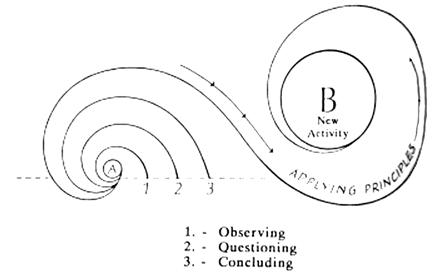Summer 1990 // Volume 28 // Number 2 // Ideas at Work // 2IAW2
Learning by Understanding the Doing
Abstract
Learning by doing, a foundation of Extension education, guarantees full learning when linked with reflection. Observing, questioning, and concluding, the basic skills of reflection, are the true signposts of learning.
Can we find these signposts of learning in our 4-H project work? Do our fairs and camps emphasize learning by doing, and also provide the time and guidance for reflection?
We're only half way there when we allow leaders and members to hurry off with crated rabbits and ribbons. Far more important than the well-earned ribbon are the principles behind rabbit showmanship. These principles need to be identified and applied to new circumstances.
Thinking about reflective learning in terms of a spiral enables us to add the needed ingredient to our project work. In Figure 1, "A" represents the activity. After the activity is completed and with adult guidance, members' observations (1), questions (2), and conclusions (3) are explored and drawn out. Members then become involved in a new activity (B) to apply the newly acquired principles.

Figure 1. Spiral learning application of reflective skills.
This concept of spiral learningwas tested in a hands-on 4-H Marine Science Program in Anchorage, Alaska. Although the 4-H record has many of the same features as the journal, the record is rarely used in a group format. Much of the time, a record is put together long after the activity is completed. In reflective learning, the process is kept dynamic in that the basic reflective skills are discussed among members. Talking about the action either during the activity or immediately afterwards is the key to obtaining a fuller value of learning. From this process, conclusions can be applied to new circumstances.
Members were primed in the pre-camp meeting to write down their daily observations and think about how they'd use this marine science experience in other areas of their lives. This continual emphasis on the basic reflective skills during meetings and activities made reflective learning possible. Learning-by-doing became learning by understanding the doing.
Discussions of the experience ranged from feelings about unfair car seating to observations about leadership styles. Conclusions ranged from how to avoid cooking too many pancakes to how to handle junior leaders who had left camp after hours. When observations and questions led to clear definitions of the problems, feelings could be expressed. Clearing the air made room for solutions. We all wanted to "make the best better." Concrete plans for the next camp materialized with ease.
The real measure of learning came the following year when those who had previously attended wanted to help develop and teach the courses. Our Marine Science Program, once a learning-by-doing project, had become obvious evidence of learning by understanding the doing.
These reflective skills are an educational strategy that can be applied to any project or program. The critical element is reflection, or thinking about, the information or experience followed by applying these principles to a new activity.
